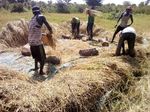Reducing Post-Harvest Losses in Olam's Rice Value Chain - Nigeria v3
←
→
Page content transcription
If your browser does not render page correctly, please read the page content below
Important instruction:
Place an image in exactly
the same position as this
Reducing Post-Harvest Losses grey box.
in Olam’s Rice Value Chain
Subtitle
PilotDate
and Study: Nigeria Rice Outgrower Select the image.
[Mac] in the menu, select
Initiative
19 October 2018
‘Arrange’ and then ‘Send
to Back’. [PC] right click
and then ‘send to Back’.
This will then render the
green box on top of the
Olam International Ltd image.Food loss as a business case for Olam:
Core purpose and “Waste” as a new material area
According to the FAO, a third of the food
currently produced never reaches our
plates. This equates to 1.3 billion tonnes of
food waste, a £470 billion economic loss
and 3.3 billion tonnes of CO2 emissions
globally every year.
Waste recently launched as a
new Olam Material Area
“Minimising food loss and
waste to improve global food
security and reduce emissions”
Focus areas for Olam
§ Crop and product losses
§ Natural resource utilisation
§ Operational Waste
1The potential of rice, the world’s most
produced staple crop
Targets to reduce post-harvest
losses are being set at national level
and by global business partnerships.
Source:
IRRI
TARGET 12.3
By 2030, halve per capita global food
Rice feeds half of humanity: it is a staple food crop for more than 50% of the world’s waste at the retail and consumer
population and has a 90% correlation with poverty, where almost all rice production is levels and reduce food losses along
grown on smallholder farms of 0.5 – 3 ha. production and supply chains,
including post-harvest losses.
Today, in smallholder rice value chains, losses are “accepted” as part of the process.
Nearly 30% of cereal and legume crops (milled rice included) are lost through to
breakage, spillage, as well as attacks from rodents, insects, mould and bacteria.
Production is where most loss happens, but poor processing, transportation and Food Loss Resolution (2017)
storage also results in rice being spilled or spoiled before getting to consumers.
Prevent and reduce food loss by 50%
Rice paddies are the largest man-made source of methane. It is the world’s most within our own operations by 2030
polluting crop by emissions, from the biomass (leaves, stalks) that decomposes in fields. versus a 2018 baseline.
For every 1% reduction in PHL in rice value chains, by conservative estimates, we
can mitigate 5MMTCO2eq every year, contributing to a Zero Carbon world by 2050.
2Food Loss: Occurrences and Prevention
Food loss at the production stage is The most effective actions for addressing food
more prevalent in developing regions loss and waste is prevention (or “source
reduction” strategies).
Preventing food from being lost or wasted in the first
place avoids the use of water, agricultural chemicals,
energy, and other resources for food production,
processing, transportation, packaging and disposal.
% kcal lost and wasted
In Sub-Saharan Africa, 39% of losses occur
during the production stages.
Assessing Corporate Performance on Food Waste Reduction:
A Strategic Guide for Investors. April 2017
PHL interventions ensure that returns are maximized
Losses during threshing Losses during re-bagging Losses through prolonged
exposure to sunlight
on the production investments that SHFs make.
3Pilot study on post-harvest losses in Olam
rice value chain, Nigeria
How do losses in Olam smallholder rice value
chains compare with rice losses observed in
FAO and IFAD study?
Supported by The Rockefeller Foundation’s YieldWise Food Loss Program Harvest • Non-observance of the agricultural
working with global business to measure food loss in supply chains. calendar (early harvest), presence of birds and
rodents in the field
Food loss (FL) is the decrease in quantity or quality of food during harvesting, Drying • Panicles dried in the village in a
post harvest handling, storage, distribution and consumption (FAO). rudimentary way, often on the ground, without
protection against poultry or humid weather
Threshing/winnowing • Poor drying affects the
Food Loss solutions in rice value chains can contribute to : effectiveness of shelling and promotes insect and
§ National Agenda, Improving Nigeria’s rice self-sufficiency and reducing mold infestation
On-farm storage • Between 1 to 7 months in the
reliance on imports, whilst increasing food security, income and food farmers’ storage structures before their evacuation
availability leading to 4 to 5% qualitative losses: (mold: 3-4%,
empty husks: 0.04-2%, insects: 0.2%).
§ GHG Mitigation / Adaptation Agenda methane emissions from rice will Husking • Level of broken rice : up to 80% (which
increase as Nigeria’s growing population demand for rice increases reduces greatly the market value)
§ The Sustainable Rice Platform Standard
Value Chain in observation A 3-day delay in
OUTGROWER FARM OLAM MILL threshing grain
after proper
On farm
storage
Olam
Warehouse
moisture level is
achieved can
Transport
lead to 50% loss
due to
increased
16,723 farmers on 18,722 Hectares Milling capacity of 195,000Mts breakage (FAO).
4Kick-off Workshop: 5th & 6th October, Nigeria
A 2-day workshop between Wageningen researchers, Olam Management team and, Olam field coordinators,
women group leaders and farmers from Olam Rice Outgrowers Initiative’s four states: Taraba, Plateau,
Nasarawa and Benue.
REACH OF OLAM RICE OUTGROWERS INITIATIVE
Workshop highlights:
State N of Land Area 2018
§ Explain the scope of study and validate each value chain step with Farmers (Ha) Estimated
stakeholders Procurement
§ A breakout session to obtain detailed information on each value from Initiative
chain step Benue 9,590 9,590 18,000 MT
§ Collective review of the Cool Farm Tool’s Food Loss and Waste Taraba 2,327 2,327 7,000 MT
questionnaire to validate its relevance for the context
Nasarawa 2,912 2,912 5,000 MT
§ Presentation of the project work flow and responsibilities to conduct
observations, surveys and direct measurement of food loss Plateau 1,894 3,893 10,000 MT
§ Presentation of the Food Loss and Waste measurement protocol Total 16,723 18,722 40,000 MT
“Before, I thought
losses were
unavoidable, inevitable
but the workshop has
taught me that small
changes can prevent
losses” For farmers, estimating losses is much harder than anticipated.
Losses are somewhat “accepted” as part of their farming process.
5Surveys and direct field measurements
in alignment with the Cool Farm Tool FLW Module
and the WRI FLW Standard
FOOD LOSS & WASTE SURVEY DIRECT FIELD MEASUREMENTS
Asking farmers to estimate losses in kg or bags of paddy, Methodology: Tracking the load of 3 different “one
based on previous farming years to identify hotspots / square meter samples”, taken from one 1 hectare field
areas for improvements
Tracking 80 loads of paddy across 4 states
Farmer self-assessment survey questions on: “Although it does not replicate the field conditions in which rice is
- Farmer process, practices and tools used harvested, piled, heaped, threshed or winnowed, it is the most
- Farmer estimated losses reliable way to measure losses throughout the rice value chain.”
- Causes for loss (when known)
- Farmer preventive measures (when taken) Measuring weight and moisture content
before and after each value chain stage
80 farmers to be surveyed across 4 states
Step 1 Observation Step 5 Winnowing
Post kick-off workshop, the survey was adapted to Step 2 Cutting Step 6 Bagging
farmer practices in Nigeria’s rice value chain to best Step 3 Piling & Heaping Step 7 Transportation
capture data. Step 4 Threshing Step 8 Storage
For farmers, the most difficult stage to quantify loss is When measuring on-farm losses,
during harvesting, when “shattering” takes place. A loss “traditional practices” are not uniform
that occurs when the paddy is ready for harvest. - Time of harvest - No. of days paddy is
“When the grains are mature, they fall on the ground - Distance travelled with cut paddy left to dry in the field
like rain drops”. - Quality of bag used (new vs re-used) - Storage conditions
Loss measurement
exercise from cutting to
winnowing took 1 hour.
After the “dry-run”,
participants led a strategy
session to discuss the
outcome of the exercise.
6Next steps
Pilot’s next steps:
§ Conduct Field Observations, Farmer Interviews, Direct Value Chain
Measurements, Stakeholder Interviews, and GHG Data Collection *Cool
Farm Tool)
State Schedule
Taraba 23rd – 27th October
Plateau 29th – 03rd November
Nasarawa and Benue 12th – 17th November
§ Analyse rice loss data based on interviews and field measurements
results
§ Include pilot learnings in the review of the Cool Farm Tool FLW module,
to be launched by Q2 2019.
Olam’s next steps:
§ Use the learnings from the pilot to measure losses across other rice
value chains and extend measurement approach to other crops
§ Measure losses across all milling stages for Olam rice mill
Currently, milling output is quantified in terms of a) packaged rice volumes, and b) husks
and other losses.
Once farm improvement practices are implemented and losses are reduced, understanding
losses at the mill will be key to translate avoided post-harvest losses at farm level into
maximum commercial value and food availability.
7You can also read



























































